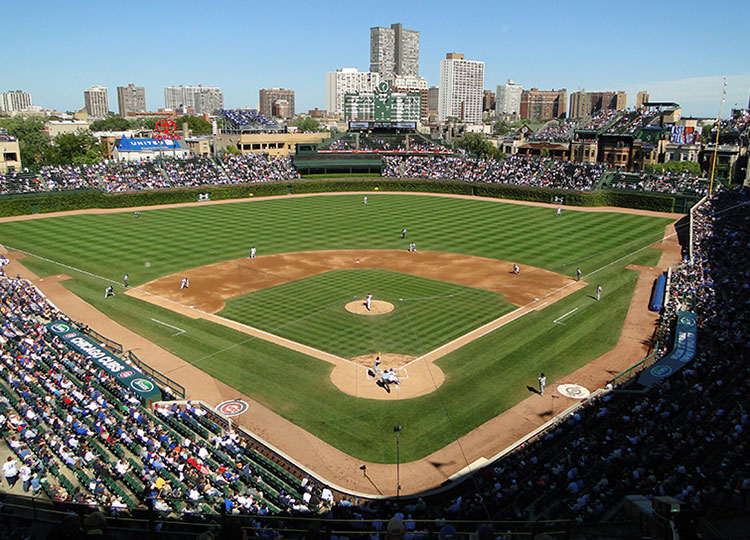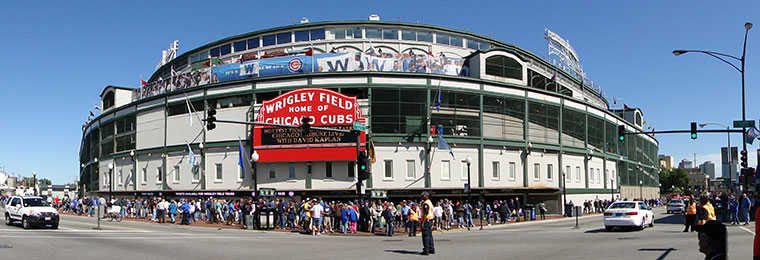
|
There are dozens and dozens of articles, reviews, and books written about the Friendly Confines of Chicago’s Wrigley Field. Ninety five years after it opened, I finally had the opportunity to step inside the Majors' second oldest ballpark (Wrigley is two years junior to Fenway Park) and form my own opinion.
Of the things that are written, it is the history of the building and the love of the fans that are most talked about. Everyone knows that the Cubs have great fans, but it is a testament to the organization and the surrounding community that the team has been selling out home games for decades no matter their record in the standings. Wrigley Field is in the heart of Wrigleyville, an area made up of restaurants, bars, pizza stands, and some stores. The neighborhood is a perfect fit for the stadium. The community loves the team and on game days you feel as if you are part of a huge block party or even Mardi Gras. And just for added fun, head to Cubby Bear across from the stadium to see fans in full Cubs’ gear bumping and grinding on the dance floor. The very long bus ride from the Blue Line 'L' Station to the park was filled with chatty and fun fans. That ambience carries over into Wrigley Field, where the narrow concourse teems with mouths agape in awe at just being there (or maybe that was just me) and people laughing, getting food or souvenirs, and generally having a great time. Then you make your way to a set of stairs, knowing that in seconds you will ascend to the box level seats and see the field for the first time. For me, I was giddy weeks before when the decision to make the trip was made. I was anxious as the date approached. And I was beaming with excitement when we were able to get tickets four rows behind the visitor’s dugout -- the opponents just happened to be my favorite team, the Florida Marlins. But I internally recognized as I approached the stairs that I was about to see a game at Wrigley and be a part of the history. My anticipation did me no wrong. As my view of concrete quickly turned into blue sky and green grass I had that transported moment, when adult becomes child, and I was just so happy. With its intimate feel and seats at all levels not far from the field, it was a living postcard. Unlike most contemporary ballparks, Wrigley is right up front with their product. You have a stadium. You have a field. You have two teams and you play baseball. And that is part of the allure. The building is a shrine to baseball and its fans, to decades of greats who wore the Cubs jersey and the players and memorable moments that took place within its walls. The modern distractions of kids zones, dancing girls, mascot races, and fireworks are absent so they don’t mess with the experience and they would probably just rob it of all its charm if they were present. I recognized immediately that I would have a harder time watching the game than usual because I kept looking around, soaking it all in. The stadium and fans were my distraction and I was OK with that. When we first made our way to our seats I had expected old, wooden seats, but they were replaced with more comfortable and modern ones years ago. Even an hour before game time the well-known bleachers were already filled with boisterous fans, and the rooftop seats on buildings along Sheffield and Waveland Avenues were already crowded. People just love being in and around this park. And as I said, history is one of the main reasons why.
I loved seeing the smiles on kids' faces, the families, the frat boy outings and the general fan young and old. In fact, when we met the people sitting in front of us we were told of one signature fan, Dorothy Farrell, who is as part of Wrigley now as anyone else. Dorothy has been sitting in the front row, by herself, for the past 23 years. When I asked her how she got her single ticket she said it was through a friend who died and I wondered about her husband. Did he not like to go to games? “He died ten years ago, “ she confided, “but the one ticket was all I wanted because I couldn’t wait to go to the games to get away from him.” I laughed because this is how Dorothy is known. She is a forthright person and a passionate fan. A Cubs employee brought her a scorecard before the game, which she kept track of from the first out through the last. Players, both Cubs and Marlins, said hi. Even Marlins owner Jeffrey Loria took a second to acknowledge her. Dorothy is the part of Wrigley I didn’t know about and the part I was looking to find. She even told me to shut up and sit down when the Marlins’ Cody Ross hit a solo home run. Thanks, Dorothy. I can tell you that there are things that I wish were a bit different, even as much as I loved the whole day at the park. Food vendors are nice, but the Cubs literally go overboard with the assembly line of people hawking food. We’d have beer guy, followed by soda guy, peanut girl, cotton candy dude, hot dog man, then repeat. There was no stopping the train. It became very annoying to try and watch the game around these vendors, and we were in the fourth row. Back on the concourse the choices for food were far less than that of most of the newer parks. And if you are a woman at Wrigley, ugh; the wait for every ladies room rivaled depression era unemployment lines. I felt sorry for that gender as I ambled past them and right into the men’s room with no wait to use the trough. Of every 7th Inning Stretch I have ever been a part of, it was here at Wrigley I had always wanted to be. The Cubs traditionally have a celebrity lead the crowd in signing Take Me Out to the Ball Game now that Harry Caray is gone. It just so happened that we were treated to Chicago’s very own Peter Cetera (from the mega-hit band that shares its name with the Windy City). And when the Cubs recorded their final out and were declared winners 6-1, we also got to see and hear the other Cubs anthem, Go Cubs Go, which is sung by the crowd after every win. The song was written in 1983 by dying fan Steve Goodman and adopted as a stadium staple in 2007 (Goodman also wrote my longtime favorite, A Dying Cub Fan’s Last Request). While the crowd sings the Cubs hoist a white flag with a blue W to signify their win. The exterior of the stadium is just as notable as the interior and is one of the most photographed in baseball. The large “Wrigley Field Home of Chicago Cubs” marquee flashes “Cubs Win!!!” when appropriate. Team pennants are positioned on top of the stadium. Statues of Ernie Banks (“Let’s Play Two”) and Harry Caray are photo ops, and fans have even purchased personalized bricks to commemorate their fandom. And this is the first time I have been at a ballpark where some of the players just walk out of the stadium and get into a cab. Some were more successful at alluding fans and autograph seekers than others. The question I was asked most about my trip to Wrigley Field was how I rank the ballpark. It certainly has its flaws and shows its age, and some players even hate the close quarters of the locker rooms and the fact that most games are still played during the day (the first night game didn't take place until 1988). But I think anything negative about Wrigley really is a positive. It continues to draw sell out crowds, fans from all over the country (like myself who came from New Mexico), and embraces the community as much as the community embraces the team. For all of that, I score Wrigley Field as a HOME RUN. There was no dollar spent on tickets, food, hotel, and pint after pint of beer that I regret because I got to go to Wrigley. I can’t wait to go back someday with my kid.

Wrigley Field Facts, Figures & Footnotes
| ||||||||||||||||||||||||||||||||||||||||


 The Cubs have a lot of yesterdays that make up today. Both foul poles are adorned with “Hey Hey,” the signature shout of their longtime radio announcer Jack Brickhouse. On top of the poles flags with the names and retired numbers of past Cubs greats are flown. Harry Caray’s image is hung nicely over the press box where for years he led fans in signing Take Me Out to the Ball Game. Babe Ruth's famous called shot happened here, as did the Steve Bartman incident and the advent of throwing opposing team's home runs back onto the field. Wrigley itself is famous for ivy hugging the outfield wall (which is more or less lush depending on the time of season) and the large hand-operated scoreboard in center field, which has been in use since 1937. I knew all of this going in, but the first-hand experience of it was what I was after.
The Cubs have a lot of yesterdays that make up today. Both foul poles are adorned with “Hey Hey,” the signature shout of their longtime radio announcer Jack Brickhouse. On top of the poles flags with the names and retired numbers of past Cubs greats are flown. Harry Caray’s image is hung nicely over the press box where for years he led fans in signing Take Me Out to the Ball Game. Babe Ruth's famous called shot happened here, as did the Steve Bartman incident and the advent of throwing opposing team's home runs back onto the field. Wrigley itself is famous for ivy hugging the outfield wall (which is more or less lush depending on the time of season) and the large hand-operated scoreboard in center field, which has been in use since 1937. I knew all of this going in, but the first-hand experience of it was what I was after.
